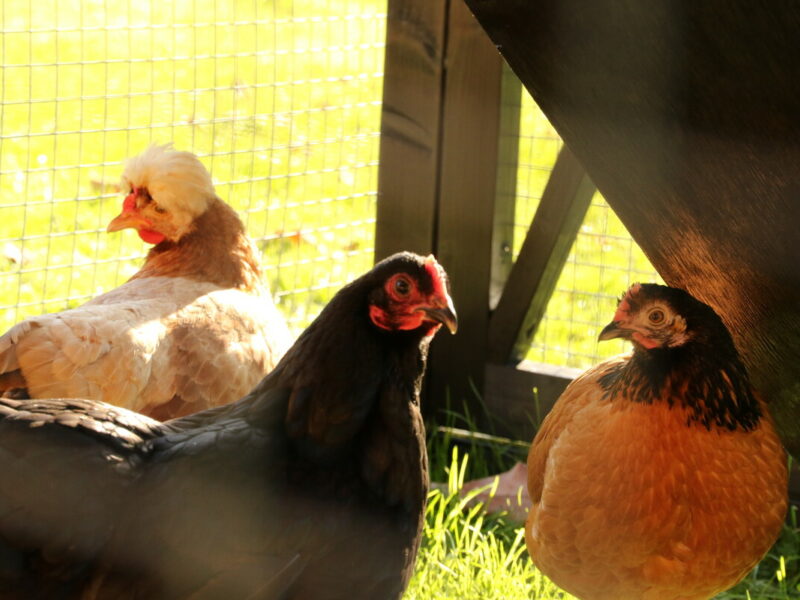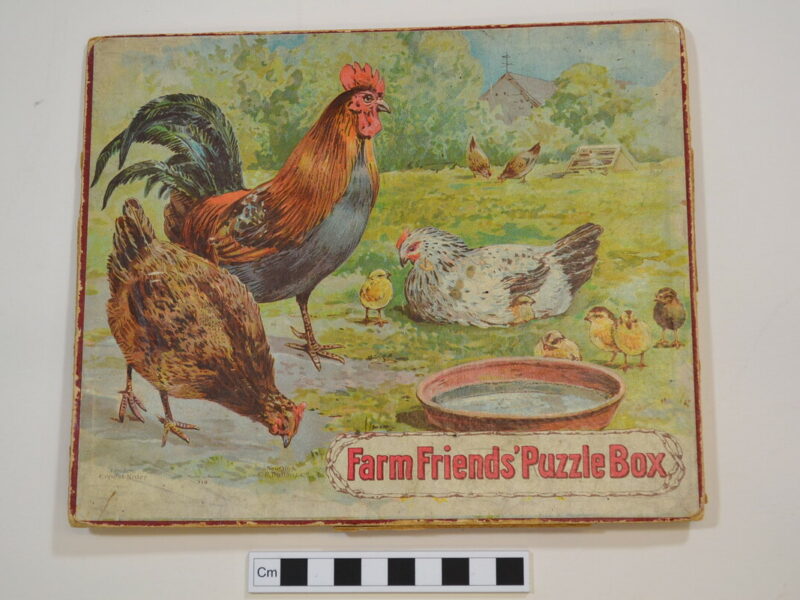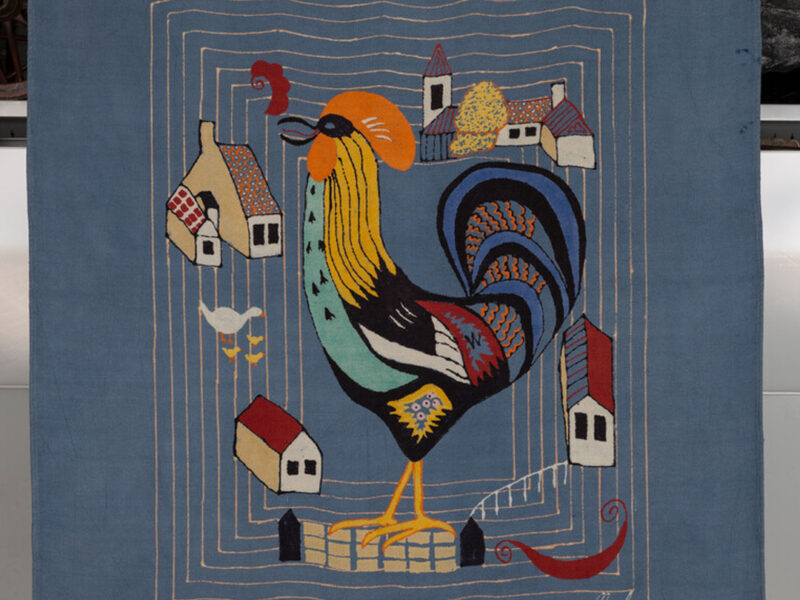‘Rooster, hang on!’ a traditional symbol in the nowadays context
Introduction
One of the most striking images to emerge from the conflict in Ukraine is that of the decorated cockerel pitcher perched atop a kitchen cabinet, that survived a bombed-out apartment in Borodianka, outside Kyiv. For a few days in April, the image was seen around the world, and when Boris Johnson visited the Ukrainian capital he was presented with a cockerel of his own.
We were fascinated by this image of rural craft in a context of conflict and wanted to know more about the artwork and its history. As a member of the International Association of Agricultural Museums (AIMA) we were able to reach out to Dr Oksana Mykytenko, of the Rylsky Institute for Art Studies, Folklore and Ethnology, National Academy of Sciences of Ukraine, who agreed to write a piece on the history of the cockerel, or rooster, which the world saw via news channels and social media.
Of course, The Museum of English Rural Life also has an interest in representations of chickens, hens, and cockerels. We have looked after a couple of hens in our garden since 2017 when a hen house was commissioned and created during an artist’s residency by Christine Mackey. In the same year, we purchased a small hanging of a cockerel made by artist, Michael O’Connell who created the decorative textile backdrop for the Countryside Pavilion of the 1951 Festival of Britain. We also have multiple images of cockerels and hens in some of holdings relating to our project, Collecting 20th Century Rural Cultures. These include popular illustrations on jigsaws such as the ‘Farm Friends’ puzzle box manufactured by the company owned by Ernest Nister (1841-1906). One of our founding collections, that of HJ Massingham, contains a corn or ‘cock dolly’ made by a Worcestershire thatcher in 1937. According to Massingham, these dollies were placed on the top of hayricks or mounted on poles as weathervanes as the cockerel was a popular symbol of harvest.
The image and mannerisms of the cockerel or rooster are so well represented in our language and culture that we barely notice them. We talk about people being ‘cocky’, ‘cock sure’, or ‘the cock of the walk’ when they resemble the cockerel in brilliant tail and head feathers strutting about. We all recognise the distinctive and sometimes comical call of the cockerel and associate it with being woken at dawn or at least far too early. Cockerels and hens are popular images for so many well-known brands of food, representing fresh, wholesome and traditional foodstuffs. The same seems to be true in Ukraine and Dr Mykytenko describes something of the Slavic and Ukrainian cultures where the cockerel is also part of mythology, fairy tales and proverbs. Decorative motifs for clothing draw on its colourful crest, beard and tail feathers, including in embroidery on shirts, mittens and towels, as well as the traditional Slavic headdress for women, the Kokoshnik.
Now dubbed ‘The Heroic Rooster’ or the ‘Ukrainian Phoenix’, the ceramic cockerel of Borodianka is seen by some as a symbol of the resilience and invincibility of the country. We are truly grateful to Dr Mykytenko and her research student, Mariya Doğan, for sharing this important article.
Isabel Hughes
Head of Curatorial & Public Engagement
The Museum of English Rural Life
‘ROOSTER, HANG ON!’ A TRADITIONAL SYMBOL IN THE NOWADAYS CONTEXT
А потім бомби влучили у спокій
(And then bombs hit tranquillity)
Lina Kostenko, Ukrainian poet
In the conditions of the large-scale social and cultural changes that followed the Russian invasion of Ukraine in 2022, visual content on social media has acquired particular importance for cultural anthropology, creating ‘an invaluable and unique source for current and retrospective understanding of social experience’ (Polovynchak, Beregelsky 2022: 24).
Accounts and images of Ukraine’s resistance to the military aggression, widely presented in public expressions on social networks and in numerous artistic reflections of individual authors, have become the embodiment and testament of the national combat and therefore need comprehensive scientific generalisation, analysis, and preservation.
Artistic symbols–the most important in contemporary culture and perhaps the most relevant language today–frequently act as a form of modelling reality. In conditions where even ordinary household items gain the weight of historical documents, many such symbols become ‘signs-symbols’ and receive the significance of ‘icons’, as expressed by Charles Sanders Pierce in his typology of signs (Pierce 2000).
The Heroic Rooster from Borodianka
Today, the legendary ceramic rooster of Borodianka has become one such symbol of national resistance and indestructibility. The Ukrainian artistic and decorative product does not cease to be a topic of Internet memes that have become well-known around the world. ‘The Rooster from Borodianka’, also known as the ‘Ukrainian Phoenix’, symbolises the endurance and courage of Ukraine, which found itself, at a terrible cost, at the epicentre of international events, worldwide sympathy and support. According to Yuriy Scherbak, Ukrainian writer, publicist and activist, this war has become the most tragic existential event in Ukrainian history. It raises questions about the very existence of its people and statehood. Nothing like this has ever happened in Ukraine’s history. Over 10 million Ukrainians lost their homes, were uprooted and displaced (Scherbak 2022a, 2022b). According to the United Nations International Organisation for Migration, at the end of July more than six million people were forced to change their area of residence within Ukraine. The Office of the United Nations High Commissioner for Refugees claims that a further 7.5 million citizens left the borders of Ukraine, of which 3.3 million received the status of ‘temporary protection’ (data as of 14 June 2022). The number of casualties is yet to be counted.
In Borodianka, a village in Bucha region which lies North of the capital, a ceramic pitcher in the form of a rooster became a witness of terrible destruction. An aerial bomb destroyed almost half a panel building, its stairwell, and flats from the first to the fifth floor. However, in one of the apartments, a small kitchen cabinet with neatly arranged dishes and a ceramic pitcher hung firmly to the wall. The Borodianka rooster ‘saw’ how the first bomb hit the house where he lived, the second bomb targeted the house across the street, where people were hiding in the basement, the third bomb destroyed the kindergarten in the yard. The rooster also possessed its own ‘memory’ as an attribute of domesticity of the pre-war daily life.
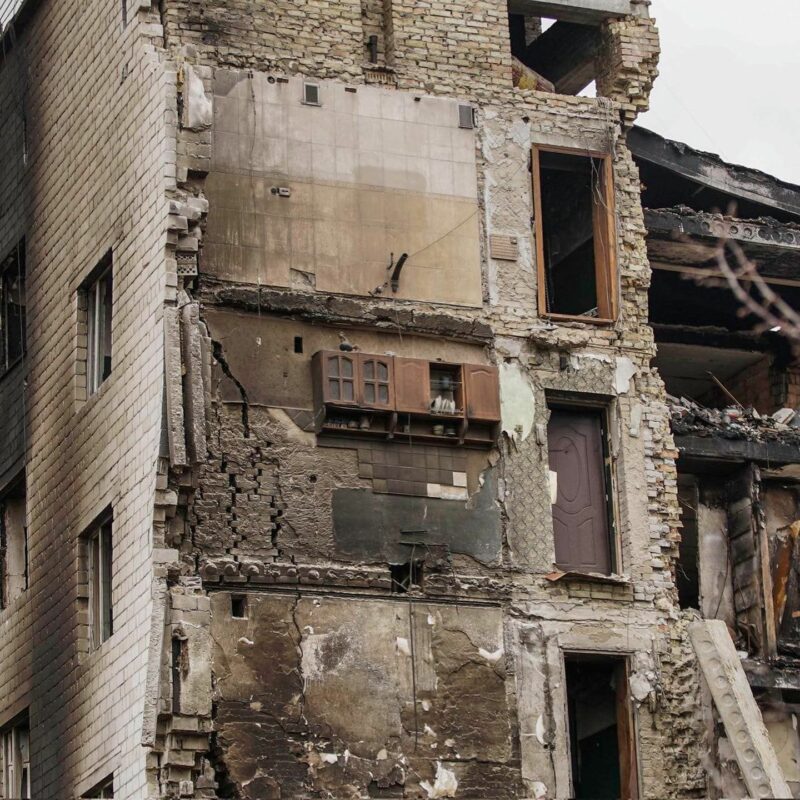
Thus, the life story of Mrs. Nadiia Svatko, the owner of the destroyed apartment in which the legendary rooster hung on, acquires the significance of a historical document and an indictment. In interview, Nadiia revealed that her husband was a liquidator of the tragic accident at the Chernobyl nuclear power plant and died in 1986. The widow also outlived her two sons: after the older one passed away, the younger brother was taking care of the mother; he was the one who firmly mounted the kitchen cabinet to the wall of their apartment. Nadiia said that on February 25, she had just finished cooking soup when terrible shelling began. She left the house to hide in the basement of a house nearby, but never had a chance to return home. The next day she left for the safety of Western Ukraine, taking with her only the few belongings that she was able to rescue from the destroyed apartment (Maksymets’ 2022).
The photograph of the kitchen cabinet with the ceramic rooster on top was taken on 6 April by photojournalist Elizaveta Servatynska, who visited villages to the north of the Ukrainian capital soon after Russian troops retreated from the region. The photographer commented that not far from the village’s border, she saw a destroyed building:
There was only a wall with a door into nowhere and a kitchen cabinet. This surprised me. The flat was gone, together with its seething life, but the cabinet was unharmed. I took a few steps backward to change the point-of-view, then my colleague asked me, “Have you seen that cabinet?” So I was not the only one who noticed it. I understood that I had to take that picture, although it was clear that other colleagues will also photograph it. Now my photo has its own life.
Servatynska, 2022
On 9 April, artist Valeriia Poliaskova presented ‘the very same’ roosters to the President Volodymyr Zelensky and then Prime Minister Boris Jonson during their stroll through the centre of Kyiv. This episode made headlines in major Ukrainian and international mass media, drawing the public’s attention both to the new sign of the country’s cultural heritage and to the approachability of the leaders, a trait widely publicised in opposition to the more isolated and distant image of Vladimir Putin.
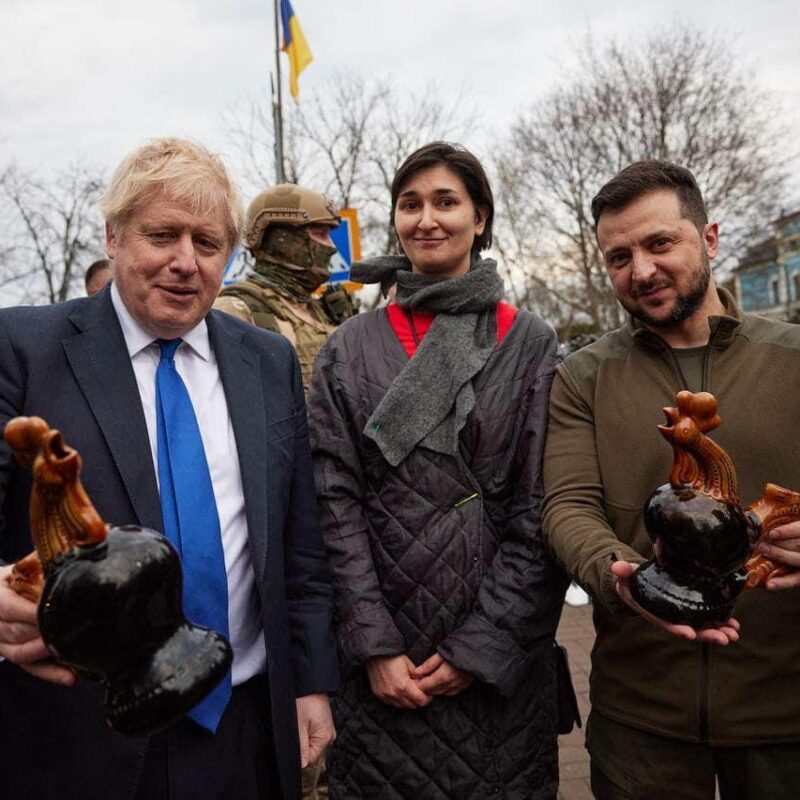
Image retrieved from https://novynarnia.com/2022/04/09/pivnyky-2/.
Following this event, much information has been revealed on the Internet concerning the artistic background of the ceramic rooster. Produced in thousands during the early second half of the twentieth century at the Vasylkiv maiolica factory near Kyiv, the pitchers were frequent features of home decoration throughout Ukraine as well as neighbouring countries. The rooster belongs to the series of tin-glazed pottery figurines titled Dobri Zviri, Nice Animals, by Valerii and Nadiia Protoriev (more on the Protorievs below).
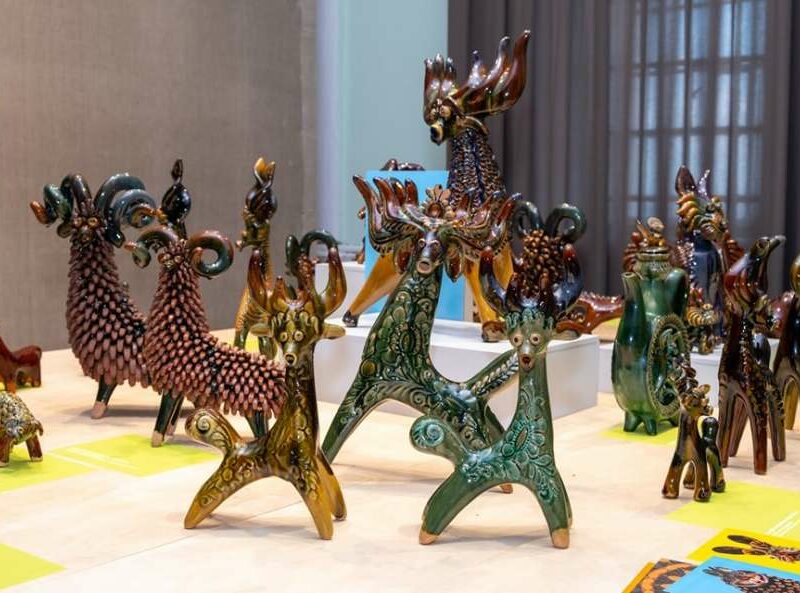
Image retrieved from https://day.kyiv.ua/uk/article/kultura/dobri-zviri-znyklogo-zavodu.
All objects in the collection follow the folk tradition of ceramic craftsmanship, united by a distinct style, and are easily recognisable. After the photograph of the rooster has gone viral, the price for Vasylkiv maiolica on Internet auctions sky-rocketed, often reaching over a thousand US dollars.
On 14 April, with the permission of Nadiia Svatko, the cabinet and fixtures were removed from the wall, while the ruins of the building and the wall itself were documented using a drone to create a 3D model that should allow the location and space to be accurately recreated in the future. The cabinet is planned to be displayed in the Museum of the Revolution of Dignity, the national memorial complex established in 2015. The museum’s Facebook page explained its interest in collecting the objects from Borodianka:
This first expedition marks the beginning of systematic work conducted by the Heritage Emergency Response Initiative and its partners in gathering the history of Russia's war against Ukraine. Our mission is to record and preserve tangible and intangible evidence of Ukrainian resistance and courage, their ability to help each other, mutual support and intransigence to the enemy, and the heroic struggle of Ukrainians for dignity and freedom. Borodianka's symbol of resistance, eternity, and victory of light over darkness is now in the Museum Fund of Ukraine.
Poshyvailo, 2022
Internet text: the new cultural heritage
In the last week of April, less than a month after the photograph of the the symbolic rooster, a monument appeared in the town of Berezne in Rivno district. A two-metre-high rooster from cement replicated the style and colour scheme of the famous jar from Vasylkiv majolica. The location was no less meaningful – the town’s central square, Independence Square.
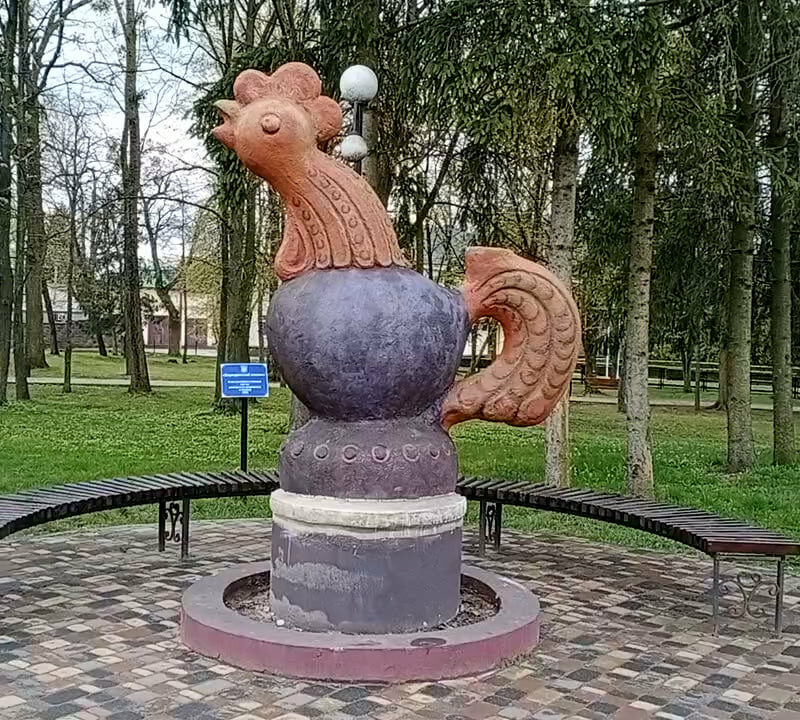
Image retrieved from https://rivne.online/archives/63178.
The monument’s maker was Oleksandr Serdiuk, an Honored Artist of Ukraine and associate professor at the Department of Drawing in Kharkiv State Academy of Design and Fine Arts. Following massive shelling and air attacks on Kharkiv and neighboring regions, the artist relocated to Western Ukraine, where he submitted his project to the territorial administration of Berezne, supported by the head of the local territorial community, Ruslan Pylypchuk.
In one interview, Serdiuk made the following comment concerning his choice of the subject:
Now, the Borodianka Rooster is a symbol of our resilience, invincibility; one can even say our glory and authenticity. We will win. “Everything will be Ukraine!”
Serdiuk, speaking to ITV Media Group, April 2022
Residents and visitors welcomed the monument and it became a new tourist attraction and location for photographs. One of the guests commented that ‘roosters announce the beginning of a new day, that the sun has risen. This is what will happen: the darkness together with Russia will have gone into oblivion, and in the new sunlight, Ukraine will blossom’ (Vasylenko 2022).
The following transfer of meaning is characteristic of the myth-making process we can observe in the Vasylkiv rooster. Bradley E. Wiggins explains in The Discursive Power of Memes in Digital Culture (2019) that image-based conceptual messages elevate the role and significance of semiotics (meaning making) and intertextuality (the relationships between different texts and artworks). The absence of speech requires audiences to employ other methods of recreating meaning. The monument of the rooster in Berezne can only acquire its full relevance through combination with the original rooster of Borodianka.
Internet communities and mass media have popularised images of objects from everyday life recovered from previously occupied territories as symbols of Ukrainian resistance. The Vasylkiv rooster from Borodianka is one example. However, the Borodianka cabinet and the Vasylkiv rooster would not have acquired its meaning of the stamina and unity of the Ukrainian people had it not gone viral through social networks and Internet communities.
Ukrainian illustrator Oleksandr Grekhov posted a drawing which recreated the already famous wall of the destroyed Borodianka apartment on 7 April and included an inscription, Trymaimosia, meaning ‘Hang on’.

Image retrieved from https://www.bbc.com/ukrainian/news-61059744.
The Internet community picked up the image and popularised it with similar messages: ‘How are you? – I hang on’, ‘Be strong like this kitchen cabinet’, and ‘We are all a bit like that kitchen cabinet’. People paid attention to the rooster, the cabinet, the other dishes, and how each survived. ‘This rooster is now my idol!’ ‘After the war we will all need the carpenter who made this kitchen cabinet; and that rooster’s psychologist’


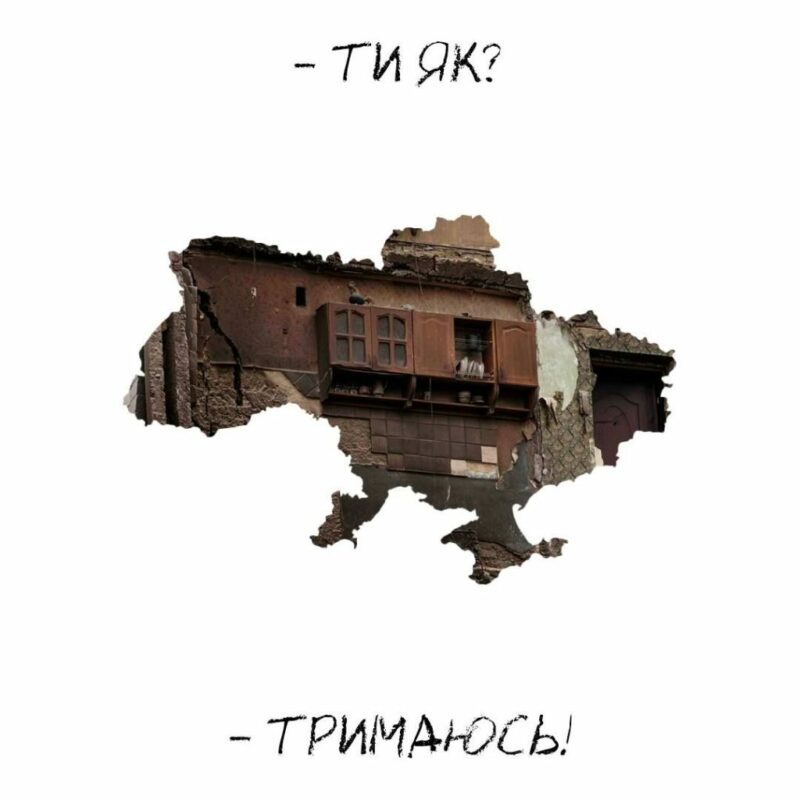
In this case, though we know the authors of the photograph and the drawing, it is significant that their identities are secondary to the circulation of the meme. It reflects folkloric practice of using and manipulating such images through sharing, remixing, and modification, not through the pregorative of the author. Richard Dawkins introduced the idea of memes in The Selfish Gene, where he outlined that their nature lies in cultural transmission through imitation and interplay. It is, therefore, vital for the effective functioning of a meme that both their creators and audience share common opinions and awareness of social, cultural, and historical contexts. Internet memes, Wriggins writes, are ‘visual arguments […] with intertextual references to reflect an ideological practice’. In other words, only viewers aware of the events in Borodianka can understand the images’ meaning. Through processes like allegory, analogy, metaphor, and parody, the Vasylkiv rooster acquired the power and symbolism of a culture-keeper and a national symbol.
The Vasylkiv Maiolica
Pottery is an integral part of the cultural heritage of Ukraine. Ceramic forms evoke the worldview of the nation. As makers continue to develop and refine the aesthetic norms of the centuries-old craft, they reveal the evolving moral imperatives and daily lives of changing societies. The ethno-cultural artistic code of Ukrainian people remains within the art of pottery, which continue to nourish our ethnic culture. Ceramics are close to the spiritual world of our contemporaries. Made by hand and exquisite in colour, they preserve an echo of ancient folk traditions. Even today, ceramics remain preferred as a means of decoration for apartments and interiors of public buildings (Dekorativno-prikladnoe iskusstvo… :121).
The pottery of the Kyiv region holds importance in Ukrainian cultural space. Local craftspeople tend to highlight the emotional expressiveness of their works by reinterpreting the traditional symbolism used in ancient sources, adding current trends and innovations while simultaneously embracing the individual creativity of different artists. The centuries-old traditions of pottery embellishment uphold its significance in the modern craft, as found today in the work of contemporary craftspeople, professional artists and designers (Paslavska 2013: 278).
Located in the middle reaches of the Dnipro River, known as Polissia, and the forest steppe, the Kyiv region was particularly favourable for the development of pottery due to its rich deposits of high-quality clay. Renowned for its several major trade routes, in the eighteenth century the region was celebrated for its centres of pottery manufacturing, including those in the village of Vasylkiv.
Vasylkiv makers sold their wares to buyers in larger neighbouring towns, including Bila Tserkva, Stavyshcha, and Fastov, who then marketed it across the country. In 1928, sixteen individual potters united in an artel (a cooperative of craftspeople living and working together) named Ceramic. Initially, Ceramic produced only simple pottery products, such as pots, bowls and makitras (large ceramic pots). Gradually, the makers added new products to their wares as they improved their technology, including slipware painting and traditional Ukrainian decorative ornaments.
The Vasylkiv Maiolica Factory developed from the base of the artel in 1934, and it soon became one of the leaders in the pottery industry of Ukraine. Most of its production line consisted of an assortment of tableware and decorative products made with the recognisable style of traditional Ukrainian pottery. The factory produced more than seventy forms of ceramics, including vases, bowls, cups, jugs, and decorative plates. Alongside household tableware, the Vasylkiv makers created decorative items like ceramic figurines, statuettes and other ornamental objects . Mostly, these were handmade items with bird motifs, with roosters being among the most popular. At the same time, ceramic roosters were not exclusively decorative: they were pitchers, artistic and practical, and favourites of traditional Ukrainian ceramic tableware.
The products and crafts of the Vasylkiv Maiolica Factory became highly popular. They were displayed in exhibitions in Ukraine and beyond and sold in stores in various major cities, particularly Kyiv and Moscow. Almost every Ukrainian household had at least one decorative or everyday item made by Vasylkiv masters. In 2000, the factory stopped production due to bankruptcy. However, a private enterprise named Vasylkivska Maiolika opened in 2005 at the site of the former premises, which continues to produce traditional Ukrainian handcrafted pottery today.
The Vasylkiv maiolica is simple in shape and environmentally friendly, made from local natural materials. You can distinguish it through numerous artistic features. They are decorated with coloured clay, using original handcrafted techniques. The ceramic paintings depict thin, curved lines situated closely together with rows of dots repeating a linear contour. Amongst the most popular plant patterns were leaves with linear processing inside the mold, grape motifs and combs. Vasylkiv paintings are characterised by soft, warm, and less vibrant designs, sometimes with graphic asymmetry (Paslavska 2013: 282). After firing in the kiln, smooth colour transitions marked the earthenware. The colour range peculiar to these ceramics varies within shades of yellow, brown and green. A combined use of glazing (when one colour slightly overlaps another) is usual for many products of the Vasylkiv factory. You can observe this on the example of the heroic rooster, or the example pot below!
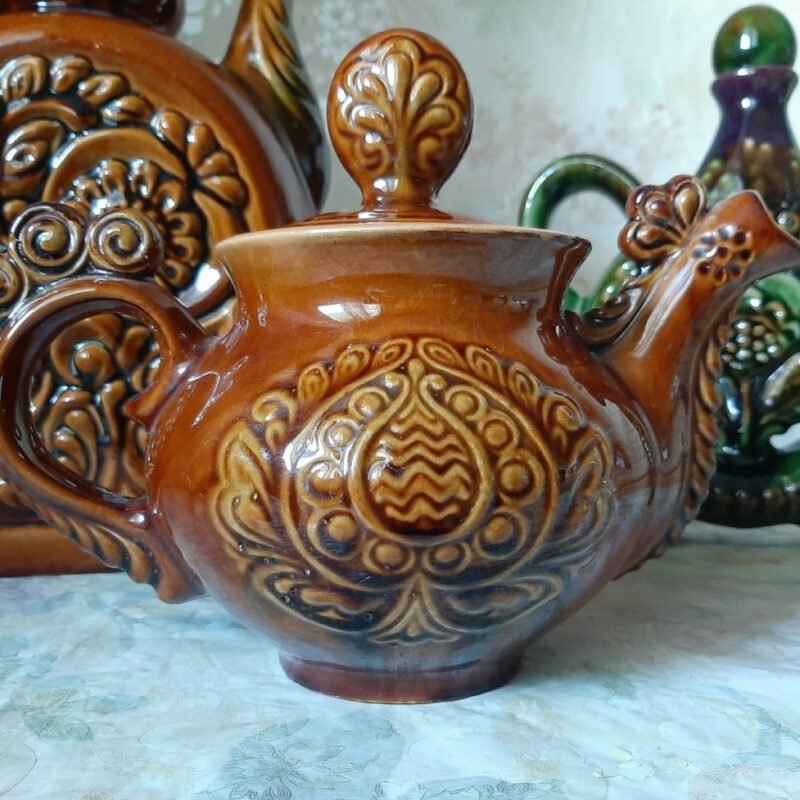
Image retrieved from https://ogolosha.ua/prod/kuvshini-vasilkivskiy-mayolika-108-234-2a2ry.html.
Masters of Ukrainian folk ceramics
According to experts at the National Museum of Ukrainian Folk and Decorative Art, the ceramic rooster was created by the Protorievs, a husband-and-wife partnership who worked together at the Vasylkiv majolica factory.
The last Chief Artist at the Vasylkiv factory, Serhiy Denysenko, shares this interpretation. Valerii Semenovych Protoriev (1924-1997) and his wife Nadiia Yukhimivna Protoriev (1926-2005) were celebrated masters of artistic ceramics and members of the Union of Artists of Ukraine. Full of bright creativity, the Protoriev family dedicated their lives to serving national culture and the national artistic tradition.
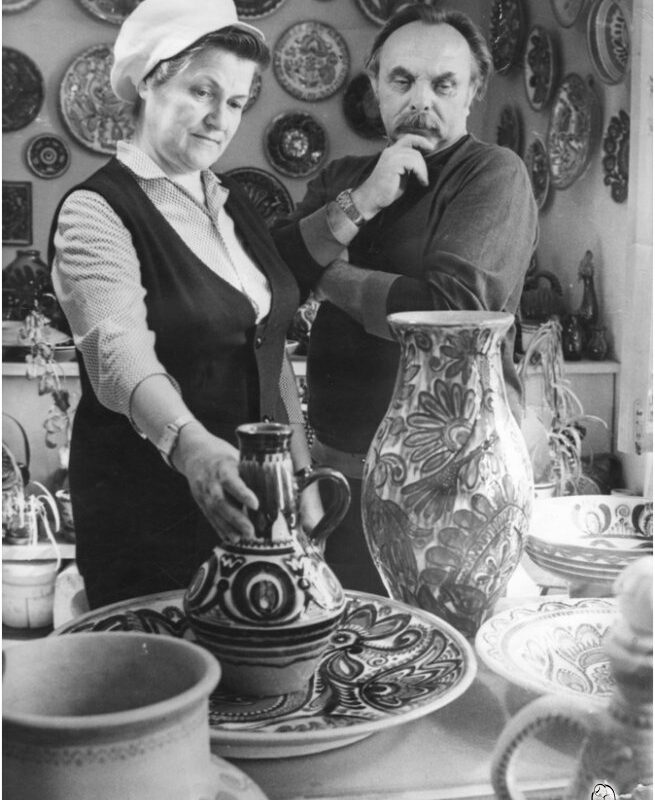
Image retrieved from https://www.facebook.com/groups/276100523295952/posts/315298126042858/.
We know little information about the couple’s background. Both acquainted with Ukrainian aesthetic heritage since childhood, Valerii and Nadiia found themselves at the Kyiv School of Applied Arts, where they studied in 1946-1950. Valerii, born in Voronivtsi village (the Khmilnytskyi district of the Vinnytsia region), and Nadiia, from Dubivka village (the Brusyliv district of the Zhytomyr region), developed their creative capabilities and artistic talent at the academy, which remains the foremost institution of art education in Ukraine. After their graduation in 1950, the Protorievs started working at the Vasylkiv maiolica factory, jointly producing sculptural products of small forms, including decorative vases and plates, souvenirs and gift sets, using folk traditions of moulding, and ornamentation.
The Protorievs’ oeuvre includes figured tableware with motifs from The Forest Song (a poetic play by renowned Ukrainian writer Lesya Ukrainka), vases inspired by the poetry of Taras Shevchenko (a foremost Ukrainian literary figure), and a plate with a portrait of Kobzar (itinerant bards in nineteenth century Ukraine). The Protorievs’ artistic pottery was exhibited at numerous exhibitions in Ukraine and abroad, representing innovative and artistically perfected Vasylkiv ceramics (Yuvan 2015: 372). Nowadays, the artists’ works—including the heroic rooster—are on display in various museums of Ukraine, among which are the National Museum of Taras Shevchenko and the National Museum of Ukrainian Folk and Decorative Art in Kyiv.
Traditional semantics of the rooster
Numerous studies have explored the symbolism of animal and bird imagery in various ethnocultural traditions. Thinking about the unique zoological code of cultural narratives, many scholars point to the importance of zoomorphic (animal) tropes in expressing the traditional worldviews of different peoples and places. In folk representations, creatures regularly possess characteristics that correspond to how people perceive the animals around them, as well as symbolising both the mythological realm and the natural world. Simultaneously, these representations and perceptions become refracted through the prisms of mythological thought (Gura 1997: 18). Using ethnolinguistic analysis, we can explore these animal symbols, recreate fragments of historic worldviews, and understand the meaning and purpose of different historical zoological codes.
Ukrainian folklore (including traditional rituals and beliefs, omens, and divinations) widely reflects mythological ideas about roosters and hens—animals that the Slavs have always venerated (Maslova 1978: 164)—and they frequently feature as characters in Ukrainian folk art. You can regularly find roosters in traditional embroidery, portrayed with a visual richness that evokes their naturally vivid plumage. You can spot them in the iconography of national architecture and decorative arts, paintings, wood carvings, lubok printings, traditional toys, and folk embroidery. In fairy tales, they appear as allegories of human relationships. Folklore (including proverbs and sayings, spells, riddles, rhymes and phraseological constructions) and folk beliefs (omens, superstitions, and bylichkas) form significant materials for understanding mythological representation, as their stable and formulaic character endures over time.
Folk art, characterised by the simplicity of its depictions, often presents roosters metonymically, symbolising the whole animal through focusing on specific details such as its crest, beard, or lavish curved tail. In the Slavic tradition, you can find these details on kokoshnik (traditional headdresses worn by women), embroidered mittens, shirt hemlines, and towel decorations. One popular Ukrainian folk song alludes to this: a scarf embroidered with ‘roosters, hens, different figures’ (Maslova 1978: 67). In other folk contexts, the rooster is represented first and foremost by its cry: in Ukrainian piven, Bulgarian and Macedonian petel, Serbian and Croatian petao, Belarus and Russian dialectal pevun, pevushek, peun, and petel. We see this in several riddles. For instance, in Russian: ‘A lout stands on two claws, his hair is to the ground, his voice is to the Lord God’; ‘Ivan the Fool sits on kobonek and sings red songs’; and ‘Who is the best singer in the world?’ (Mitrofanova 1968: 42-43).
In many traditions, the rooster’s symbolism revolves around its connection to the sun. Much mythology sees the rooster as a solar guide in annual and daily cycles. In Ukrainian riddles, for example, the rooster often becomes the sun’s personification: ‘A rooster on a willow tree has lowered his plaits to the ground’. The essence of the symbolic image manifests itself in the fact that the rooster acts as a messenger. Like the sun, the rooster ‘counts the time’. Consider, for example, Russian phraseological collocations like первые петухи (‘the first roosters’ meaning ‘before dawn’), вторые петухи (‘the second roosters’ or ‘the crack of dawn’), третьи петухи (‘the third roosters’ or ‘dawn’), as well as expressions like ‘get up before the roosters’, ‘wake up with the roosters’, or ‘sleep through the roosters’. In French, the most common noun for the rooster used in fairy tales and fables is chante-clair, literally meaning ‘the singing dawn’ (from chanter, ‘to sing’, and cler, ‘clear, clearly’). This belief is reflected in folk riddles about the rooster: ‘Not a clock but tells the time’; ‘Not a guard, but wakes up everyone early in the morning’, and so on. There are also synonymous riddles where the correct answer is a clock: ‘The rooster crows, his feathers are dangling’ (Toporov 1992: 309; Dal’ 1882: 555). Such interpretation of the image is characteristic of how language develops. Connections to sunrise and sunset with roosters were made because in traditional cultures the cries of animals and birds were used as signals, whether for the beginning of certain household chores or as precursors to particular events. Thus, they were endowed with magical powers, which became interpreted and explored through acts like divinations, folk beliefs and rituals (Gura 1997: 81). Solar symbolism varied with the historical context and geography of different regions, and the rooster was just one of many zoomorphic incarnations of the sun.
In many places, the rooster’s blood-red crest and bright plumage also led to associations with fire. The rooster often personifies flames, as in, for example, the Polish czerwony kur (‘the red rooster’) and the Russian ‘put a red rooster on the roof’. Ukrainians used to believe that a landlord’s dream of a rooster (or, specifically, a red rooster) could be understood as a prophecy of fire! In other riddles, fire and the sun become interchangeable, such as the Russian ‘The red rooster is running up the perch’ (Gura, Uzenjova 2009: 28). Among Slavic, Baltic and German peoples, the red rooster was a symbol of the deity of fire and sun. These links led to perceptions of storms and lightning as manifestations of heavenly fire, which is reflected in omens and superstitions, weather predictions, and divinations. Not only are there legends saying that a red rooster jumps down from the sky together with lightning and sets houses on fire, but red roosters were offered as a sacrifice to this fire deity. This connection between the rooster and lightning is reflected in material culture: tin figurines of roosters were placed on roofs to protect properties from lightning (Birikh 2007: 529-560).
In traditional mythology, the rooster’s association with the sun has led to it becoming a sacred symbol and totem. Several studies have observed connections between the applied arts of Ancient Rus and those of the Scythians. Ancient Scythia occupied almost the entire territory of contemporary Ukraine, and at some places spread beyond its borders (Yanovich 2004: 13). All peoples of the Eurasian steppes worshipped the sun and there are notable similarities between images of a rooster among the Slavs and early nomads. Contemporary archaeological excavations in Altai have revealed about seventy objects portraying rooster imagery that date back to the middle of the first millennium BCE. Most of them are not individual items, but an entire series of identical articles that were used for decorating clothing, horse equipment, and cult items. In addition, there are gold plaques that originated from the northern Black Sea region and the Kuban and one golden figurine from Kyrgyzstan (Barkova 2015: 143).
The authors of the current article had the chance to see and observe this miniature golden figurine of a rooster at the Kyrgyz State History Museum in Bishkek. The object that is merely 2.4 centimetres in height was revealed in Kayrak burial ground in Ketmen-Töbö settlement. The sculptured figure and profile of the rooster, despite its small size, is exceptionally detailed: it has a high crest, one round eye, a powerful beak and beard, a slender neck that gracefully curves, folded wings with sharp outlines and elaborate reliefs of feathers, and a bold tail covered with furrows imitating plumage. Liudmila Barkova in her article ‘Representations of the rooster in the Art of Altai’ argues that such depictions can give both an idea about the worldview of early nomads and their mythological system: on the one hand roosters were understood as representatives of the earthly part of the world, and at the same time they acted as a link to the heavens and the divine. This connection attributed the animal with the power to announce the arrival of a new day and the appearance of the sun in the sky. Indeed, he acts as a symbol of the sun (Barkova 2015: 155).

As a symbol of creating day and life, the rooster has become heavily related to love and fertility. You can observe this in aspects of wedding ceremonies, like the gifting of ceremonial dishes shaped like a rooster or a hen, taking a dressed-up rooster to the groom’s house, and ritual dances called bolshoy petuh in Russian and kohutovy tanec in Slovenian. The custom of feeding a rooster or a hen to newlyweds which took place in the bedroom during the wedding night was ascribed the magical power of increasing reproductive potential. Kokoshnik (Russian for a headdress of a young married woman) is etymologically connected with the term kokosh which in ancient times meant a rooster and a hen. In the Ukrainian Zhytomyr region, the bride’s female friends were often expected to visit the new wife in the groom’s house on the second day of the wedding and sing: ‘Didn’t our hen come all the way to you? / If she did, then sprinkle some seeds for her / so that she gets used to your rooster’. Bulgarian Petlov Day and Babyn Day (or ‘Woman’s Day’) also have connotations of initiation, where the rooster symbolises male potency (Maslova 1978: 165; Gura, Uzenjova 2009: 32). The same metaphorical employment can be found in literary texts: ‘I hated him – the thin, horny man-rooster who fell for that juicy, heavy-set, busty woman who still wanted to read him morals’. (Chendey 2020: 107).
As the light of the new day casts away the darkness, the rooster’s cry–and its connotations of sun and dawn–often served an apotropaic and protective function, meaning that it was used to ward off the evil eye. He operated on the same level as the ringing of a church bell to counteract the forces of evil. For example, a Latvian folksong conveys historically accurate images of the rooster-guard that would be placed on the spiers of houses, masts, steeples, and weathervanes:
Beautifully do Riga cocks sing
At the top of tall towers;
More beautifully our nightingale
In a fine bird-cherry bush
Lielbārdis, 2014: LD 30615
The rooster’s chthonic nature can be observed in a belief from traditional Croatian mythology, which featured a large snake that could crow like a rooster. Among the Serbs, the qualities of the snake are transferred back to a rooster, which became attributed with extraordinary power. On the approach of a hail cloud, for instance, it was perceived that the rooster would hide under a threshold, leaving its body while its spirit soared into the sky to fight with khala: dragons (Gura, Uzenjova 2009: 31). In other contexts, the crowing of the rooster was said to expel evil forces, remove diseases, and eliminate the influence of death. It was believed that the rooster’s first cry dispelled witches, werewolves, the walking dead, and other spirits of the night, as well as causing evil spells to lose their powers. Magical formulas of healing enchantments were said to send ailments and diseases to places ‘where the rooster does not sing’, the world of the dead. Even today, kurinyi bog (‘hen’s god’) amulets, made of a small pebble or a shell with a natural hole, are widely known and used by children to hang around one’s neck as a charm against evil or injury. Although its name is not accidental, the mythological significance of this object has long been forgotten. A pebble (or in some cases an old bast sandal, a lapot, or the neck of a broken jug) would be hung in a stable or beneath a perch to protect chicken and livestock from evil spirits, particularly from kikimora, female house spirits that might plague members of a household (Levkievskaia 2009: 77).
As well as fending off evil, roosters were used symbolically as sacrifices of appeasement and to prevent disaster. Sacrificial ceremonies and associated ritual actions reflected this: a bird could be buried alive, placed in the ground at a village border to expel cholera, symbolically used in ploughing, bathed in a river or well, or immured during the construction of a house. Using a rooster or hen to appease a need for sacrifice is reflected in other folk beliefs. One is that if someone feared they had felled a sacred tree, they must behead a live chicken on the same treestump using the same axe. Similar actions were recorded among the Serbs if a lush tree was chopped down (Synchuk 2015: 55). And in the same way that the rooster keeps us safe, it was said the cry of a rooster announced the resurrection of Christ (Toporov 1992).
One contemporary poet who explores the rooster’s associations with Christ is Lina Kostenko. A combination of poetics of folklore and biblical texts characterise her work, refracting a vivid perception of reality and national tradition within a deep philosophical reading of the Bible. Similar to the New Testament, where the image of the rooster takes on the symbolic power of the sun, light, and Christ himself, Kostenko’s poem ‘Before the rooster crows’ uses the rooster as a sign of repentance and an emblem of St Peter:
Петро — не Юда. Він любив Учителя.
І вуст він зроду був би не отверз.
…Коли вели Ісуса до мучителя,
була сльота. Петро апостол змерз.
А тут раби і слуги архирейські
Такий вогонь великий розвели!
Петро подумав: — Я лише погріюсь,
Бо хтозна, чи ще прийдеться коли.
Він підійшов до ницих і бундючних,
І руки грів при їхньому вогні.
Слуга спитав: — Ти також його учень? —
Була сльота. Сказав апостол: — Ні.
Він так сказав, і той його облишив.
Раби і слуги підкидали хмиз.
Месію били. В груди. І в обличчя.
Вогонь горів. Петро дивився вниз.
Коли ж Ісуса повели, одмучили
і розп’яли в такій височині,
слуга спитав: — Ти був між його учнями? —
Горів вогонь. Петро промовив: — Ні.
Він руки грів і зневажав Пілата.
В своєму серці плакав і скорбів.
Але вогонь продовжував палати.
І він сидів, як раб серед рабів.
Бо ж розіпнуть. І хто ж тоді нестиме
святе учення у майбутні дні?
Слуга сказав: — Я ж бачив тебе з тими! —
І втрете він тоді відрікся: — Ні.
Ну, Петре, як? Зігрів свої долоні?
Урятувався? Догоряє хмиз…
Тебе розіпнуть десь аж при Нероні.
Зате інакше: головою вниз.
Peter is not Judas. He loved the Master.
And he would never open his mouth.
…When they led Jesus to the torturer,
There was slush. Peter the Apostle froze.
And here the slaves and servants of the bishopric
Such a big fire was lit!
Peter thought: — I’ll just warm up,
Because who knows if it will come, and when.
He approached the lowly and the poor,
And he warmed his hands by their fire.
The servant asked: – Are you also his student? —
There was slush. Said the apostle: – No.
He said so, and he left him.
Slaves and servants threw brushwood.
The Messiah was beaten. In the chest. And in the face.
The fire was burning. Peter looked down.
When Jesus was taken away, they tortured him
and crucified at such a height,
the servant asked: – Were you among his students? —
The fire was burning. Peter said: – No.
He warmed his hands and despised Pilate.
He cried and grieved in his heart.
But the fire continued to burn.
And he sat like a slave among slaves.
Because they will be crucified.
And then who will carry it
holy teaching in the days to come?
The servant said: – I saw you with those! —
And for the third time he refused: – No.
Well, Peter, how? Did you warm your hands?
Did you save yourself? The brush is burning…
You will be crucified somewhere near Nero.
But it’s different: head down.
Kostenko, 2010: 38
The symbol of the rooster – and its connotations of daybreak and light – are presented very differently in an image in poetic by lines by Serhiy Zhadan:
Сонце, мов півень із відрубаною головою, б’є крильми
Вітає цей дивний світ, найсправедливіший зі світів (Zhadan 2018: 13).
(The sun, like a rooster with a severed head, beats its wings
Welcomes this strange world, the fairest of worlds).
The parody-burlesque antithesis balances travesty and tragedy. The suggestive image, built on a contextual oxymoron, conveys the feeling of an impending catastrophe. The demonstratively decorative image of Zhadan is loosely associated with Pablo Picasso’s poetic ‘Guernica’ (1937), in which distorted faces are fragmentarily piled up, animal heads represent violence and chaos.
In place of conclusions…
My life after the fateful Thursday of 24 February is like a chain of inevitable accidents. Similar to millions of my compatriots, I found myself far from my home in Kyiv, where I was born, have been living and working. Either by coincidence or by destiny, my temporary home became a city on another continent: distant Bishkek in Kyrgyzstan, the country famous for its high mountains and the majestic epos ‘Manas’.
And so, by chance or by fate, after accepting an invitation to participate in the SIEF international conference, in June I end up in Riga (Latvia). In my time free from conference sessions I walk around the ancient city and also visit the old city market, where among various shops and kiosks, I see a humble antique shop, in which, amidst the chaos of miscellaneous things, my gaze stops at a familiar majolica figure. Yes, this is the same rooster, one of many relatives that flew from the Vasylkiv maiolica factory. I ask about the price. The owner in a camouflage uniform, considering that it is an incomplete item, a jar without a lid, names five Euros. I immediately agree.
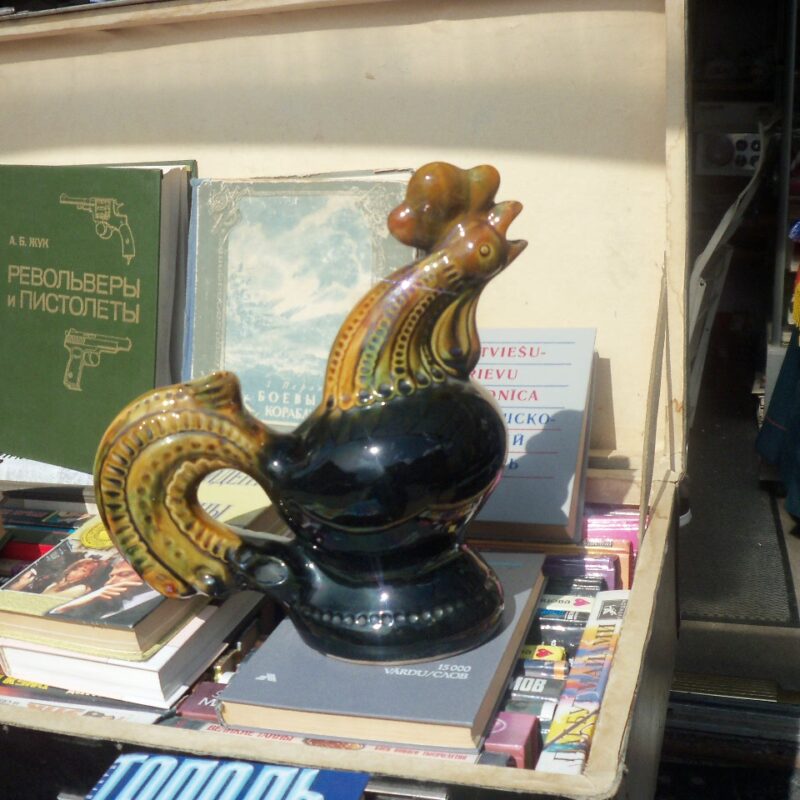
And then: I notice another small figurine of a different plastic: a starry-eyed male peasant with a moustache in a fur cap, a somewhat dreamy Ukrainian man who sits, thinking, resting his head on his hand, with a red rooster on his lap.
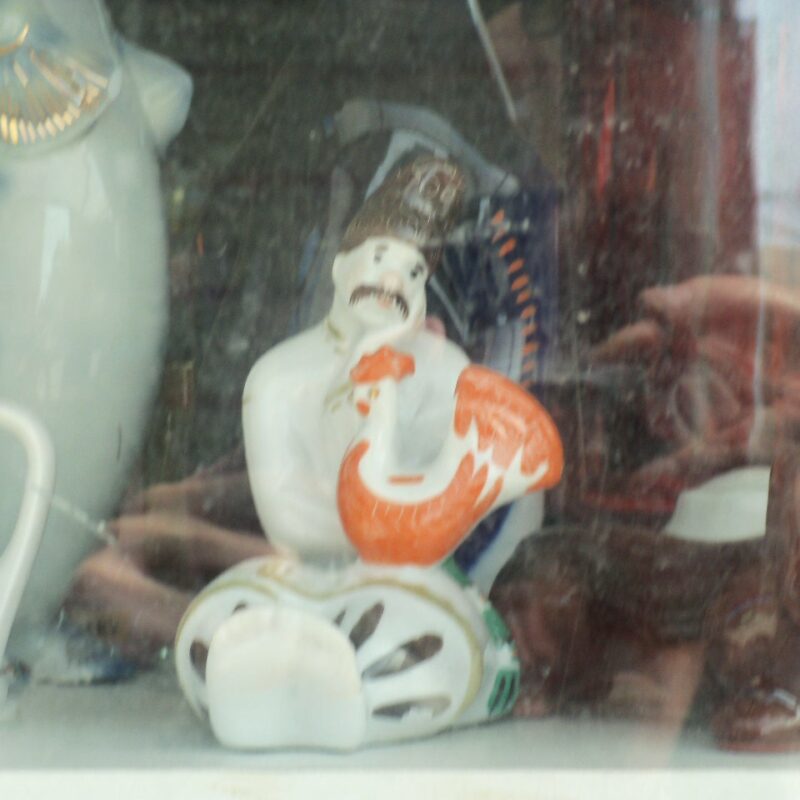
The owner says that the figurine is titled Khokhol (using an uncomplimentary colloquial term for Ukrainians), and, having sensed my interest in the roosters, already estimates it much more expensive, but we somehow reach an agreement. Wrapping both figurines in several layers of old newspapers, he also promises to find ‘something similar’ for me the next day. But in the morning of the next day, I had my flight through Istanbul to Bishkek, so the roosters were carefully packed in the suitcase.
Now, I catch a glimpse of these two figurines, washed, beautiful, bright. A symbol of Ukraine, its indomitability, endurance and courage, harbingers of our approaching victory. And it will be inevitable. It was not for nothing that the people say: everything will pass, only one truth will remain.
Professor Oksana Mykytenko is Leading Researcher at the Rylsky Institute for Art Studies, Folklore and Ethnology, part of the National Academy of Sciences of Ukraine. E-mail. ORCID: 0000-0001-7613-8557. Mariya Doğan is a PhD Candidate at the Department of American Culture and Literature, Hacettepe University. E-mail. ORCID: 0000-0001-7157-2434.
All of us at The Museum of English Rural Life are enormously grateful for the phenomenal research undertaken by Oksana and Mariya in shaping this article and sharing with us the extraordinary historic and contemporary symbolism of Ukrainian folk art and ceramics. We are also indebted to our colleagues in AIMA for introducing us to Oksana and Mariya and making this collaboration possible.
Find out more about The Museum of English Rural Life’s work and collections, or plan your visit today. Learn more about supporting Reading’s Ukraine community at www.rucc.uk.
References
Afanasyev, Alexander. (1865). Poeticheskiye Vozzreniya Slavian na Prrirodu. Opyt Sravnitel’nogo Izucheniya Slavianskikh Predaniy i Verovaniy v Sviazi s Mifologicheskimi Skazaniyami Drugikh Rodstvennykh Narodov [The Poetic Outlook of Slavs about Nature: the Experience of Comparative Study of Slavic Traditions and Beliefs, in Connection with the Mythological Legends of Other Related Peoples]. 1. Moscow: Soldatenko Publishing House.
Barkova, Lyudmila. (2015). “Izobrazhenie petukha v iskusstve drevnego Altaia” [“The cockerel design in Ancient Altai art”]. Arheologicheskiy sbornik. Materialy i issledovaniya po arheologii Altaia. Saint-Petersburg: The State Hermitage Publishers. 143-156.
Birikh А. (2007). Russkaia Frazeologiia: Istoriko-Etimologicheskiy Slovar’: Okolo 6000 Frazeologizmov [Russian Phraseology: Historical Etimological Dictionary: About 6000 Phraseological Units] / edited by Valeriy Mokienko. 3rd edition. Мoscow: Astrel: АSТ: Khranitel.
Chendey, Ivan. (2020). “Schodennyk” [“Diary”]. Kyiv (7-8), 92-129.
Dal’, Vladimir. (1882). Tolkovyi Slovar’ Zhivogo Velikorusskogo Iazyka [Explanatory Dictionary of the Living Great Russian Language] 3. Saint-Petersburg-Moscow.
——- . (2016). Poslovitsy Russkogo Naroda. Izbrannoie [Selected Proverbs of the Russian People] Edited by Buturliev V. Moscow: Bibl. of the Eurasian Assembly, Russian State Library.
Dawkins, Richard. (1989). The Selfish Gene. Oxford University Press.
Dekorativno-prikladnoe iskusstvo Ukrainskoy SSR. 1970-e – nachalo 1980-kh godov [Decorative and Applied Art of the Ukrainian SSR. The 1970s – beginning of the 1980s]. Moscow: Sovetskiy khudozhnik, 1986.
Gura, Aleksandr. (1997). Simvolika zhivotnykh v slavianskoi narodnoj traditsii [Animal Symbolizm in Slavic Folk Tradition]. Moscow: Indrik.
Gura, Аleksandr, Uzenjova, Yelena. (2009). “Petukh”. Slavianskie drevnosti. Etnolingvisticheskiy slovar’ v 5-I tomakh [Rooster. Slavic Antiquity. Ethnolinguistic Dictionary in 5 Volumes]. Edited by Nikita Tolstoy. 4. Moscow: International Relations, 28-35.
Kostenko, Lina. (2010). “Persh nizh piven’ zapie”: Z cyklu “Davydovi psalmy” [Before the Rooster Crows: From the Cycle ‘David’s Psalms’] Ukrayinska literatura v zahalnoosvitniy shkoli. (10). 37–38.
Levkievskaia, Yelena. (2009). Russkaia narodnaia mifologiia [Russian Folk Mythology]. Moscow: OGI.
Lielbārdis, Aigars (Ed.). (2014). History of Folklore Collection in Photographs: LD 30615 Silins P., Vietalva / Саbinet of Folksongs (Dainu skapis). Attachment. Riga: Institute of Literature, Folklore and Art, University of Latvia.
Maksymets’, Svitlana. (2022, July 7). “Vin trymavsia: yak pivnyk z Borodianky stav symvolom ukraiinskoii stijkosti” [“It Hung On: How a Rooster from Borodianka Became a Symbol of Ukrainian Stoicism”]. Retrieved from https://weekend.today/gorod/yak-pivnyk-z-borodyanky-stav-symvolom-stijkosti.htm
Maslova, Galina. (1978). Ornament russkoi narodnoj vyshivki kak istoriko-etnograficheskij istochnik [The Ornament of Russian Folk Embroidery as a Historical and Ethnographic Source]. Moscow: Nauka.
Mitrofanova, Vera. (Ed.). (1968). Zagadki [Riddles]. Leningrad: Nauka.
Paslavska, Lyudmyla. (2013). “Keramichni mysky Kyivshchyny kintcia XIX – pochatku XX stolittia u konteksti ukrayinskoyi narodnoyi khudozhnjoyi kultury” [Ceramic Bowls of the Kyiv Region in the End of the 19th – Beginning of the 20th Century in the Context of Ukrainian Folk Artistic Culture]. Aktualni problem istoriyi, teoriyi ta praktyky khudozhnjoyi kultury. Issue 31. 278-285.
Pierce, Charles S. (2000). Izbrannye filosofskie Proizvedeniya: Ucheniya o znakakh [Selected Philosophical Writings: The Study of Signs] (K. Golubovich, K. Chuhrukidze, T. Dmitrieva, Trans.). Moscow: Logos.
Polovynchak, Yu., Beregelsky, А. (2022). “Vizualniy kontent sotsialnykh media yak ob’jekt bibliotechnoho deponuvannia (na bazi materialiv vysvitlennia podij vijny 2022 r.” [“Visual Content of Social Media as an Object of Library Depositing (based on material of the events of 2022 war)”] Naukovi pratsi Natsional’noi biblioteky Ukraiiny imeni V.І. Vernads’koho: Zbirnyk naukovykh prats’. Kyiv, Issue 63, 23-32.
Poshyvailo, Ihor and Olha Salo. (2022, April 16). “Natsionalyi muzei revoliutsii gidnosti – Maidan Museum” [“National Museum of the Revolution of Dignity – Maidan Museum”]. Retrieved from https://www.facebook.com/maidanmuseum.org/posts/2779493119024523
Scherbak, Yurii. (2022a) “Vijna i mor” [“War and Plague”]. Slovo Prosvity. (24-25).
——-. (2022b, July 20-26). “Moia druha Vitchyzna” [My Second Motherland]. Gazeta Polska (29).
Serdiuk, Oleksandr. (2022, April 23). “Symvol stijkosti ta nezlamnosti…” [“The Symbol of Stoicism and Invincibility…”]. Retrieved from https://itvmg.com/news/simvol-stiykosti-ta-nezlamnosti-u-bereznomu-vihotovlyayut-skulpturu-pivnika-foto-yakoho-obletilo-ves-svit-foto-73181
Servatynska, Yelizaveta. (2022, April 13). “U Buchi ohopylo vidchuttia bezporadnosti…” [In Bucha the Feeling of Helplessness Engulfed…”]. Retrieved from https://suspilne.media/228131-u-buci-ohopilo-vidcutta-bezporadnosti-fotografka-suspilnogo-pro-vijnu-znimok-safki-ta-ubitih/
Sinchuk, Svetlana. (2015). “Obraz ‘ptitsa-derevo’ v slavianskoj narodnoj culture” [“The Image of ‘Bird-Tree’ in Slavic Folk Culture”]. Vestnik Slavianskikh Kultur, 4(38), 49-57.
Toporov, Vladimir. (1992). “Petukh” [“Rooster”]. Mify Narodov Mira. Encyclopedia (Sergey Tokariev, ed.) 2. Мoscow, 309-310.
Vasylenko, Tetiana. (2022, June 7). “Symvol sontsia i nezlamnosti” [“the Symbol of Sun and Invincibility”]. Sils’ki Visti. (19). Retrieved from http://www.silskivisti.kiev.ua/19963/print.php?n=51324
Wiggins, Bradley E. (2019). The Discursive Power of Memes in Digital Culture: Ideology, Semiotics, and Intertextuality. Routledge.
Yanovych, Viktor. (2004). “Geografiya Skifii po Gerodotu” [“Geography of Scythia by Herodotus”]. Ukraina Incognita (Larisa Ivshina, ed.). Kyiv: Ukrainskaia Press-gruppa. 13-16.
Yuvan, Valentina. (2015). “Protor’evy” [“The Protorievs”]. Shevchenkivska encyklopediya u 6 t. (Mykola Zhulynskiy, ed.) 5. Kyiv: Institut literatury im. T.G. Shevchenka. 372.
Zhadan, Serhiy. (2018). Antena: poezii [Antenna: poetry]. Chernivtsi: Merydian Chernovits.

